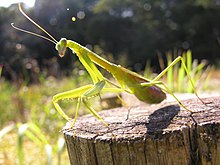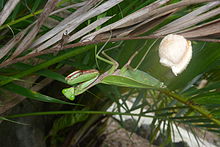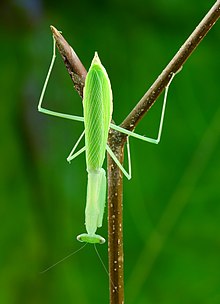Mantidae
| Mantidae | ||||||||||||
|---|---|---|---|---|---|---|---|---|---|---|---|---|

African giant mantis ( Sphodromantis viridis ) |
||||||||||||
| Systematics | ||||||||||||
|
||||||||||||
| Scientific name | ||||||||||||
| Mantidae | ||||||||||||
| Burmeister , 1838 |
The family Mantidae forms with 1,261 species, the largest family within the order of Mantis (Mantodea). This family also includes well-known representatives, including the European praying mantis ( Mantis religiosa ), the Indian giant mantis ( Hierodula membranacea ) or the Ghana praying mantis ( Sphodromantis lineola ).
features




Characteristic of the mantids is the triangular, vertical, freely moving head with two very large complex eyes and three ocelles . The shape of the head with the rounded complex eyes is common to many species of mantids, a property that occurs more frequently in terrors of other families, including the Hymenopodidae . The antennae are long and bristle-shaped. The name of the praying mantises comes from the lurking mantids, in which the front legs, which are formed into catch legs, are held forward in a characteristic way so that they give the impression of praying hands. The rail of these legs can be struck against the grooved leg like a folding knife. By folding it in and out at lightning speed, prey animals are caught and held in place by thorns. The tentacles of all species of the Mantidae have two rows of thorns, other species outside the family usually only have one row per tentacle. The middle and rear legs are long and serve as striding legs.
All species are fully winged, but the wings can be of different shapes and lengths. The fore wings lie flat over the hind wings in the lurking position. In many species the wings of the females protrude over the tip of the abdomen, in others they only cover part of the abdomen , and still others have reduced wings. The wings of the males of most species are significantly longer and make them easy to fly. This is not least due to the fact that the males of most species are significantly narrower and lighter than the often more massive and larger females. Another distinguishing feature of the sexes is the number of abdominal segments, which is eight in the male and six in the female, as is the case with all fishing horrors. To deter predators , the mantidae mantidae have eye-spots on the second pair of wings and on the inside of the muzzle, a trait that occurs in other families within the order of the mantis.
Even if the basic physique of all species within the family is uniform, the sizes and other attributes of individual species vary, particularly depending on the subfamily belonging to them. The representatives of the subfamily Mantinae , which contains the most famous species, correspond to the usual image of fishing horrors . Many representatives of this subfamily are built quite robust and long-legged. Quite a few associated species have a green basic color and are therefore adapted to their habitat . This subfamily also contains quite large species, including the green shield mantis , which also has a greatly enlarged pronotum on the thorax . Representatives of the subfamily Amelinae , ex . the small fishing insects, on the other hand, are smaller and more compact in stature. Still others, including the dead leaf ( Deroplatys lobata ), imitate withered leaves or branches (e.g. the little astmantis ) to camouflage themselves. Flower mimickers like those of the Hymenopodidae family do not occur.
The terrors have imperfect metamorphosis . Thus, the pups already resemble imagines , but differ from them, apart from the size, by the not yet fully developed wings and in some species by the upwardly curved abdomen of the adult animals.
Occurrence
The Mantidae family is found on all continents with the exception of Antarctica. Most species are found in the tropics and subtropics. Their distribution area rarely goes beyond the 45th degree of latitude south or north. Exceptions are, for example, the European praying mantis, which can still be found north of the 50th parallel in Europe, or Orthodera novaezealandicae on the South Island of New Zealand . The tropical rainforests, but also grassy areas and savannas, are part of the habitat of these terrors. Some undemanding species can also be found on agriculturally used areas such as gardens and plantations or on ruderal areas. Plants, including trees, bushes, shrubs or grasses, are often inhabited within these habitats. Species like the dead leaf inhabit leaf areas. Due to the introduction or deliberate importation by humans, some species have also spread elsewhere and now also inhabit areas in which they were not previously found.
Way of life

The species of the Mantidae family are usually ambulance hunters who linger motionless in their habitat in order to camouflage themselves and lurk there for prey. Prey animals typically represent appropriately sized arthropods. Larger species are also known to overwhelm smaller vertebrates, including mice , hummingbirds, and smaller reptiles and amphibians . The agility of different types is different. The smaller species of the subfamily Amelinae are fast runners and good jumpers. The larger representatives of other subfamilies are predominantly adapted to their way of life as ambulance hunters and only use rapid locomotion or jumps in necessary situations, for example when fleeing from a predator. Many species rely on the threatening gesture already mentioned or use their hunting weapons (tentacles and mandibles) to defend themselves against a predator.
Reproduction
The attainment of sexual maturity and the mating times are variable in the family, the latter particularly depends on the climatic zone of the habitat of the respective species. During the mating season, females willing to mate attract males with the help of pheromones. The males of some species can perceive these at a distance of several hundred meters. A male willing to mate will sometimes seek out a female of the same species because of his ability to fly. As soon as a male has been able to locate a female, it approaches it cautiously, often with courtship behavior that varies depending on the species. The courtship also serves to signal to the females that the approaching male is a member of the species willing to mate and that it can approach it safely. The cannibalism on the part of the female during mating, which is used to catch horrors, is also represented in many species of the Mantidae family, but in different forms and often far less than assumed. The representatives of the subfamily Amelinae, for example, rarely show cannibalistic behavior. The pairing can sometimes take several hours. Some time after mating, the females lay down several (less often only one) ootheca , from which the young hatch after a few weeks. The hatching rate varies depending on the species, but it is not uncommon for several hundred animals. In the temperate climate zones, the young forms overwinter in the eggs. The hatched young then mature within several moults (usually eight to ten). Because of this, younger catching horrors are to be found in the temperate climatic zones, especially in spring, while the adult animals are mostly found from late summer to autumn. The phenology of the species found in the warmer parts of the world is often less complex and the animals plant and develop there all year round.
Terrariums
Many species of the Mantidae family are now very obese as terrarium animals . The posture parameters can often vary. There are some sturdy and easy-to-keep species in the family that are particularly suitable for beginners. Examples of this can be found in the genera Sphodromantis and Hierodula . Other species, on the other hand, are a bit complicated in terms of their keeping, which can be due to higher demands on warmth and humidity or other properties. Offspring of many species are available in stores.
Biological pest control

Some species of the family were introduced for biological pest control in parts of the world that were not originally native , including the great Chinese mantis ( Tenodera sinensis ) and the European praying mantis ( Mantis religiosa ) in North America. However, this method is still controversial today, as the neozoa can cause considerable damage to the autochthonous fauna, as they often spread without natural enemies and displace native species. It is also criticized that these fishing horrors are not always suitable as a pest control, since many animals that are to be controlled by the fishing horrors, e.g. B. cockroaches , because of their way of life, they rarely encounter the terrors and they switch to other prey. The prey spectrum of the introduced fishing horrors is quite unspecific, so that useful animals are also captured.
Systematics
The Mantidae family includes 1261 species. (As of 2016)
The number of subfamilies varies between 17 and 21 depending on the author. The Photinainae are often viewed as a separate family, as are the Angelinae . The different understanding of the extent and content of the subfamilies of the Mantidae is based on the fact that no autapomorphies , that is, clear distinguishing features between the individual groups, have been defined so far . There are also several subfamilies with only one or two genera. In 2002 Reinhard Ehrmann raised some subfamilies of the Mantidae to independent families within the Mantodea, including the Liturgusidae, Tarachodidae, Thespidae, Iridopterygidae, Toxoderidae and Sibyllidae, which Beier had classified as Mantidae in 1968. Although this resulted in a reduction in the subfamilies, no further clarification of the phylogenetic relationships.
Subfamilies with selected examples
-
Amelinae
Giglio-Tos , 1919
- Lesser fishing insect ( Ameles spallanziana ( Rossi , 1792))
- Gray fishing insect ( Ameles decolor ( Charpentier , 1825))
- Fuentes short-winged fishing insect ( Apteromantis aptera ( Fuente , 1894))
- Angelinae Beier , 1964
- Antemninae Terra , 1995
- Choeradodinae Kirby , 1904
- Chroicopterinae
- Compsothespinae Handlirsch , 1926
- Danuriinae
-
Deroplatyinae Giglio-Tos , 1919
- Dead leaf ( Deroplatys lobata ( Guérin-Méneville , 1838))
- Dystactinae
- Heterochaetinae
-
Mantinae Burmeister , 1838
- Australian giant mantis ( Hierodula majuscula ( Tindale , 1923))
- Indian giant mantis ( Hierodula membranacea ( Burmeister , 1838))
- Hierodula patellifera ( Audinet-Serville , 1839)
- European praying mantis ( Mantis religiosa ( Linnaeus , 1758))
- Parasphendale agrionina ( Gerstaecker , 1869)
- Marbled Madagascar mantis (Polyspilota aeruginosa ( Goeze 1778))
- Green shield mantis ( Rhombodera basalis ( De Haan , 1842))
- Sphodromantis baccettii LaGreca & Lombardo , 1987
- African praying mantis ( Sphodromantis gatrica ( Stål , 1858))
- Ghana praying mantis ( Sphodromantis lineola ( Burmeister , 1838))
- African giant mantis ( Sphodromantis viridis ( Forsskål , 1775))
- Japanese giant mantis ( Tenodera aridifolia ( Stoll , 1813))
- Great Chinese mantis ( Tenodera sinensis Saussure , 1871)
- Mellierinae Giglio-Tos , 1919
-
Miomantinae
- Geomantis larvoides Pantel , 1896
- Miomantis binotata ( Giglio-Tos , 1911)
- Egyptian praying mantis ( Miomantis paykullii Stål , 1871)
- Orthoderinae Saussure , 1869
- Oxyothespinae Giglio-Tos , 1919
- Photinainae Giglio-Tos , 1919
- Phyllotheliinae
- Schizocephalinae Beier , 1964
- Stagmatopterinae Giglio-Tos , 1919
-
Stagmomantinae
- Stagmomantis carolina ( Johansson , 1763)
-
Vatinae Saussure , 1893
- Small Astmantis ( Popa spurca Stål , 1856)
Individual evidence
- ↑ a b c Shveta Patel, Rajendra Singh: Updated Checklist and Distribution of Mantidae (Mantodea: Insecta) of the World. In: International Journal of Research Studies in Zoology. (IJRSZ), Volume 2, No. 4, October 2016, pp. 17-54, doi: 10.20431 / 2454-941X.0204003 .
- ↑ Brisbane Insects and Spiders ( brisbaneinsects.com )
- ↑ Bernhard Klausnitzer (ed.), Erwin Stresemann: Stresemann - excursion fauna of Germany. Volume 2: Invertebrates: Insects. 11th edition. Spektrum Akademischer Verlag, 2011, ISBN 978-3-8274-2451-8 , p. 113.
- ↑ Sydney K. Brannoch, Frank Wieland, Julio Rivera, Klaus-Dieter Klass, Olivier Béthoux, Gavin J. Svenson: Manual of praying mantis morphology, nomenclature, and practices (Insecta, Mantodea). In: Zookeys. No. 696, 2017, pp. 1–100, doi: 10.3897 / zookeys.696.12542 .
- ^ A b Frank Wieland: The phylogenetic system of Mantodea (Insecta: Dictyoptera). In: Species, Phylogeny and Evolution. Volume 3, No. 1, March 2013, pp. 3–222.
- ↑ Housing parameters of some species on the website of M&M Wüst ( mantidenundmehr.de )
- ↑ Report on the impact of the Great Chinese Mantis on the North American ecosystem on the website of View from the Cape ( cmboviewfromthecape.blogspot.com )
- ↑ Ralf Schütte, Frank Wieland: Advances and perspectives in the study of the evolution and phylogeny of the Mantodea (Insecta: Dictyoptera). In: Entomology Today. Volume 29, November 2017, pp. 1–23.
- ↑ Reinhard Ehrmann: Mantodea - Praying Mantis of the World. 1st edition. Natur und Tier Verlag, 2002, ISBN 3-931587-60-6 .
- ↑ M. Beier: Mantodea (grasshoppers). In: JG Helmcke, D. Starck, H. Wermuth (Hrsg.): Handbuch der Zoologie. Volume IV: Arthropoda, 2nd half: Insecta, 2nd part: Special . Walter de Gruyter, Berlin 1968, chapter 12.













